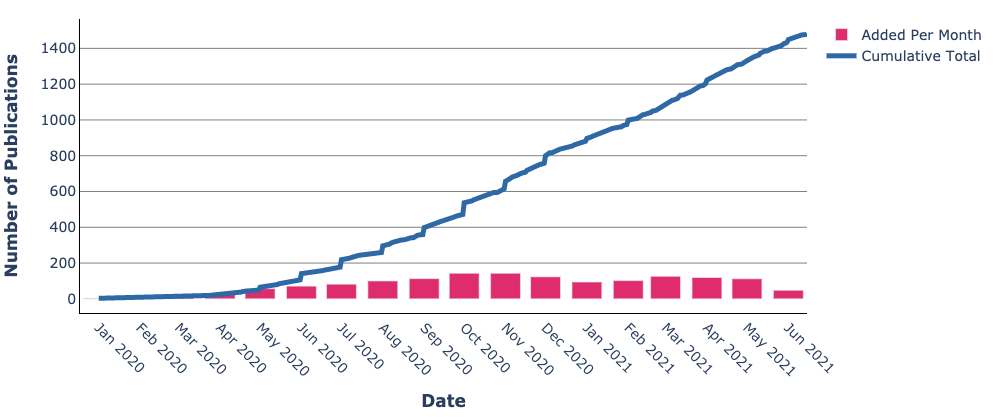The Swedish SARS-CoV-2 and COVID-19 research output since the beginning of the pandemic
Published: 2021-06-21

The current COVID-19 pandemic, caused by the SARS-CoV-2 virus, has caused a global public health crisis, and challenged societies over the last year and a half. The pandemic has also, in a short time, transformed scientific research publishing. Researchers, especially those working in life sciences, have in record time changed their focus in order to fight the pandemic. This research contributed to developing novel treatments, therapies, and vaccines for COVID-19. Below, we take a look at the numbers of global and Swedish research publications over the year and a half of the pandemic.
Research on COVID-19 has resulted in a large number of scientific publications during 2020 which continues to grow in 2021. For example, accoring to Fraser and colleagues (2021, PLoS Biology, DOI: 10.1371/journal.pbio.3000959) over 120.000 COVID-19 related scientific articles were published within the first ten month of the pandemic. Out of these, 30.000 were added to preprint servers. Else and colleages (2020, Nature, DOI: 10.1038/d41586-020-03564-y) estimated that 6% of all articles added to PubMed in 2020 were related to COVID-19. Earlier this year, Ioannidis and colleagues (2021, bioRxiv, DOI: 10.1101/2020.12.15.422900) estimated that there were over 130.000 COVID-19 related published scientific articles (based on Scopus). Please note that the estimated number of publications varies depending on which database was used, coverage, and definitions used for searches.
Overall, the number of scientific articles submitted to scientific journals has increased rapidly during 2020, independently of research subjects. For example, Squazzoni and colleagues (2002, SSRN, DOI: 10.2139/ssrn.3712813) found that the number of articles submitted to Elsevier’s journals between February-May 2020 increased 58% compared to the same period the previous year. In addition, the use of preprints has increased rapidly during the COVID-19 pandemic. medRxiv is currently the most used preprint server for COVID-19 related research, followed by SSRN, Research Square, RePEc, arXiv.org, bioRxiv, JMIR, and Preprints.org (according to the above mentioned study by Fraser and colleagues). As Ioannidis colleagues state in their conclusion, the number of researchers involved in COVID-19 research, as evidenced by numbers of co-authors on COVID-19 related scientific articles, shows the rapid and massive response to the pandemic from the scientific research community.
A large number of COVID-19/SARS-CoV-2 related journal articles and preprints published by researchers from across the world can found in publication databases such as PubMed, Europe PMC, and others. One of the features of the Swedish COVID-19 Data Portal is an in-house publications database launched in December 2020. The database is manually curated and contains all published scientific articles and preprints related to COVID-19/SARS-CoV-2 from 2020 and onwards where at least one co-author has an affiliation with a Swedish university or research institute.
According to our database, to date 1.400+ publications related to COVID-19/SARS-CoV-2 have been published by Swedish researchers. Out of these, approximately 60% are research articles, 14% are reviews, and 25% are other (comprising comments, letters, editorials etc.). At the moment, the database contains 127 preprints which have not yet been published in a journal. Out if approximately 800 published research articles, about 12.5% share data and/or analysis code according to our manual annotation.
The publications in the database are also manually assigned a research field by the portal team. The publications are divided into the following research areas: Biochemistry, Drug discovery, Genomics & transcriptomics, Health, Imaging, Proteins, Public health, Serology, and Other (filtering by research field is available in the database section). To date, most of the publications have been assigned Health label (350+), followed by Public health (170+) and Biochemistry (160+).
When it comes to the distribution of activity across the months of the pandemic, October and November 2020 were months with the most publications (approximately 150 each month). In May 2021, approximately 110 research articles and preprints were published. During the first six month of 2021, already over 600 publications have been tracked.
Data
Besides being a part of the COVID-19 data portal website, the COVID-19 publications database can be downloaded as a JSON file and used for research. The database contains publication title, author list, abstract text, journal/preprint server name and other bibliographic information as well as a manually assigned research field. For example, text mining tools could be used to ask meta-scientific questions or network analysis tools could be used to investigate collaboration patterns. More information about the publications database can found in SciLifeLab Data Repository under the DOI: 10.17044/scilifelab.14124014.